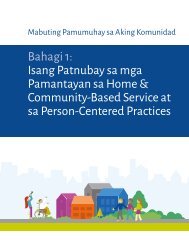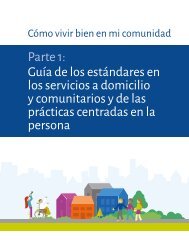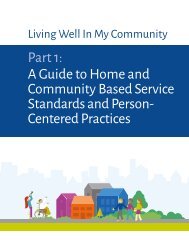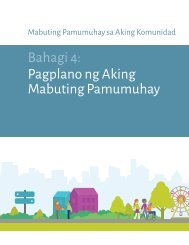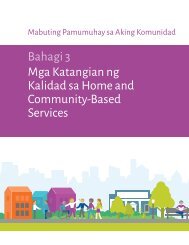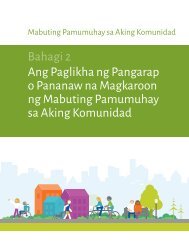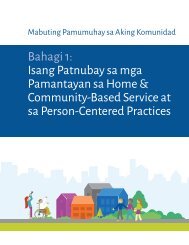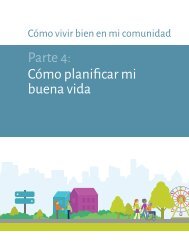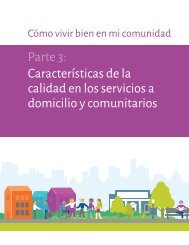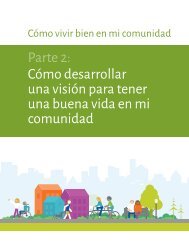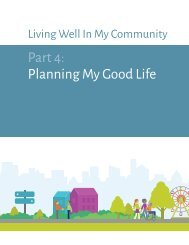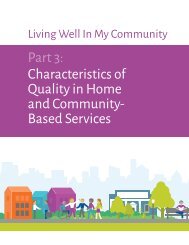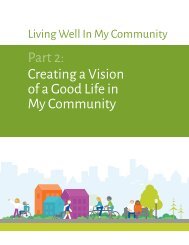Living Well In My Community Part 1 - A Guide to Home and Community-Based Service Standards and Person-Centered Practices
Create successful ePaper yourself
Turn your PDF publications into a flip-book with our unique Google optimized e-Paper software.
Provider owned or controlled residential services must also meet the<br />
following conditions<br />
Residential Condition #1: Tenants’ Rights<br />
This means that a person with a disability has the same rights <strong>and</strong> protections from eviction as<br />
other tenants.<br />
Residential Condition #2: Respect <strong>and</strong> privacy<br />
If people are living in a home owned or controlled by a service provider:<br />
1. They can lock their door.<br />
2. They can choose their roommate.<br />
3. They can decorate where they live within the terms of a lease or other agreement.<br />
Residential Condition #3: Creating personal schedules<br />
The setting enables people <strong>to</strong> have the freedom <strong>and</strong> support <strong>to</strong> control their own schedules <strong>and</strong><br />
activities <strong>and</strong> have access <strong>to</strong> food at any time.<br />
Residential Condition #4: Having visi<strong>to</strong>rs<br />
People can have visi<strong>to</strong>rs of their choosing at any time.<br />
Residential Condition #5: Accessibility at home<br />
The setting is physically accessible <strong>to</strong> the individual.<br />
How can person-centered<br />
thinking, planning, <strong>and</strong><br />
practices help?<br />
<strong>Person</strong>-centered thinking is a set of values,<br />
skills <strong>and</strong> <strong>to</strong>ols that can be used <strong>to</strong> get <strong>to</strong><br />
know someone <strong>and</strong> discover what they find<br />
important <strong>and</strong> what they want out of life. It<br />
ensures that we focus on what matters <strong>to</strong> the<br />
people we support <strong>and</strong> their family, <strong>and</strong> that<br />
we pay attention <strong>to</strong> their staff as well.<br />
<strong>Person</strong>-centered planning is an ongoing<br />
process <strong>to</strong> help people with or without<br />
disabilities <strong>to</strong> plan for their future. <strong>In</strong> personcentered<br />
planning, groups of people focus on<br />
an individual <strong>and</strong> that person's vision of what<br />
they would like <strong>to</strong> do in the future.<br />
Through a person-centered planning process,<br />
people who know <strong>and</strong> care about the person<br />
often begin <strong>to</strong> look at the person in a different<br />
way. <strong>Person</strong>-centered planning helps a person<br />
gain control over their own life. <strong>Person</strong>centered<br />
planning can increase opportunities<br />
for participating in the community. <strong>Person</strong>centered<br />
planning helps others recognize a<br />
person’s gifts, capacities, desires, interests, <strong>and</strong><br />
dreams. The planning team works <strong>to</strong>gether <strong>to</strong><br />
create action steps <strong>to</strong> turn a person’s dreams<br />
in<strong>to</strong> reality.<br />
<strong>Person</strong>-centered practices are ways of<br />
planning, providing, <strong>and</strong> organizing services<br />
by listening <strong>to</strong> what people want <strong>and</strong> helping<br />
them live in their communities based on their<br />
choices. <strong>Service</strong> providers can strengthen their<br />
A <strong>Guide</strong> <strong>to</strong> <strong>Home</strong> <strong>and</strong> <strong>Community</strong> <strong>Based</strong> <strong>Service</strong> St<strong>and</strong>ards <strong>and</strong> <strong>Person</strong>-<strong>Centered</strong> <strong>Practices</strong> 1.7




